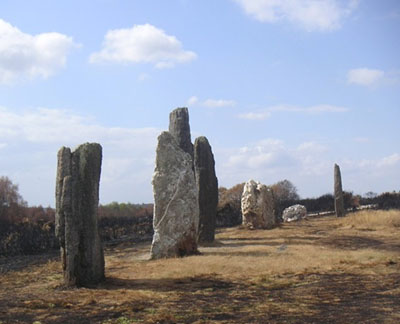 History-lovers
may think immediately of towns as the high spots of walking in Brittany, and it is true that there are some
exceptionally interesting places like Rennes and Quimper to explore. Others have enough
historic and architectural interest for a lengthy stroll: Morlaix with its
medieval houses and WWII incidents, Dinan and Vannes with elaborate city walls
remaining, Ploërmel with its ducal associations and very fine stone buildings, Pontivy
and its contrasting chateau/Napoleonic development, the unparalleled chateaux
of Fougéres (with an 18th century town above) and Vitré, with the
best preserved medieval quarter in Brittany – or Europe, many would say.
History-lovers
may think immediately of towns as the high spots of walking in Brittany, and it is true that there are some
exceptionally interesting places like Rennes and Quimper to explore. Others have enough
historic and architectural interest for a lengthy stroll: Morlaix with its
medieval houses and WWII incidents, Dinan and Vannes with elaborate city walls
remaining, Ploërmel with its ducal associations and very fine stone buildings, Pontivy
and its contrasting chateau/Napoleonic development, the unparalleled chateaux
of Fougéres (with an 18th century town above) and Vitré, with the
best preserved medieval quarter in Brittany – or Europe, many would say.
 History
haunts the Breton coast with echoes of naval warfare, smugglers and saints arriving
in stone boats competing for interest with centuries of defensive structures,
and fascinating economic detail like seaweed production and oyster cultivation.
A circuit of the restored walled city of St-Malo and its chateau museum introduces
the sea-faring history of this region, and a coastal walk to the east can take
in the historical oddity of the rock sculptures of Rothéneuf. Further on is the
Pointe du Grouin with its bird reserve on Ile des Landes, and the oyster-mecca
of Cancale (33kms from St-Malo).
History
haunts the Breton coast with echoes of naval warfare, smugglers and saints arriving
in stone boats competing for interest with centuries of defensive structures,
and fascinating economic detail like seaweed production and oyster cultivation.
A circuit of the restored walled city of St-Malo and its chateau museum introduces
the sea-faring history of this region, and a coastal walk to the east can take
in the historical oddity of the rock sculptures of Rothéneuf. Further on is the
Pointe du Grouin with its bird reserve on Ile des Landes, and the oyster-mecca
of Cancale (33kms from St-Malo).
 The 25kms
between Pointe St-Mathieu and Brest is a top choice for history lovers,
with the ruined abbey on the point enjoying dramatic seascapes. Continue past
the island Fort de Bertheaume and pause at Fort Dellec, once a Vauban fort,
later used by the Germans in WWII and today a public park with viewing
platforms over the Rade de Brest. Add lighthouses and views over to the Crozon
peninsula where Spanish troops established a fort at the narrowest point of the
channel during the Wars of Religion, and you have a day’s walk packed with
sights and sensations.
The 25kms
between Pointe St-Mathieu and Brest is a top choice for history lovers,
with the ruined abbey on the point enjoying dramatic seascapes. Continue past
the island Fort de Bertheaume and pause at Fort Dellec, once a Vauban fort,
later used by the Germans in WWII and today a public park with viewing
platforms over the Rade de Brest. Add lighthouses and views over to the Crozon
peninsula where Spanish troops established a fort at the narrowest point of the
channel during the Wars of Religion, and you have a day’s walk packed with
sights and sensations.
Those drawn to the megaliths for historical or mystic reasons can enjoy some sensational walks such as a 9km circuit at Erdeven which enables a lot of ‘up close’ examination of huge menhirs (Géants de Kerzerho, Caesar’s Chair) and some important dolmens including Mane Crac’h, and the Dolmen de Crucuno.
 Even more
remarkable because of the remote and atmospheric location on the Landes de
Cojoux are the alignments and burial sites at St-Just, north of Redon, which
include unusual structures such as The Tribunal, possibly a form of New Stone
Age calendar. A 13km circuit here takes in all the megaliths and the Etang de
Val.
Even more
remarkable because of the remote and atmospheric location on the Landes de
Cojoux are the alignments and burial sites at St-Just, north of Redon, which
include unusual structures such as The Tribunal, possibly a form of New Stone
Age calendar. A 13km circuit here takes in all the megaliths and the Etang de
Val.
Finally, a highly recommend day out would be the historical walk at Auray given in Walking in Morbihan by G.H.Randall (www.reddogbooks.com) which includes the tomb of a famous Chouan (Catholic anti-revolutionary) leader and the delightful port of St-Goustan, where Benjamin Franklin arrived in 1776 to seek French help for the American War of Independence.